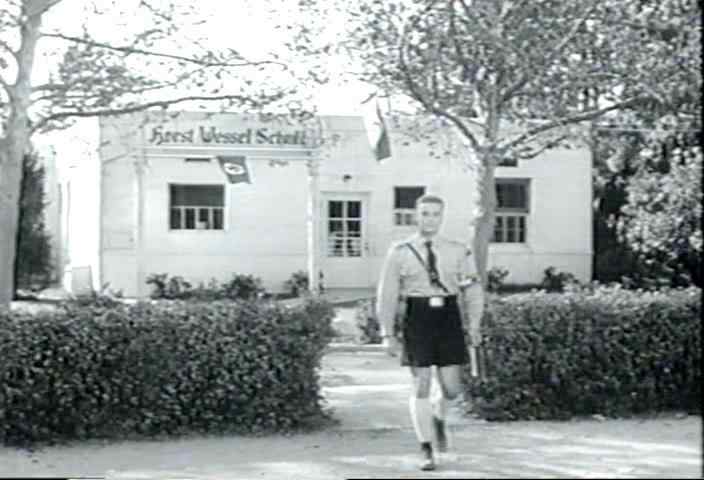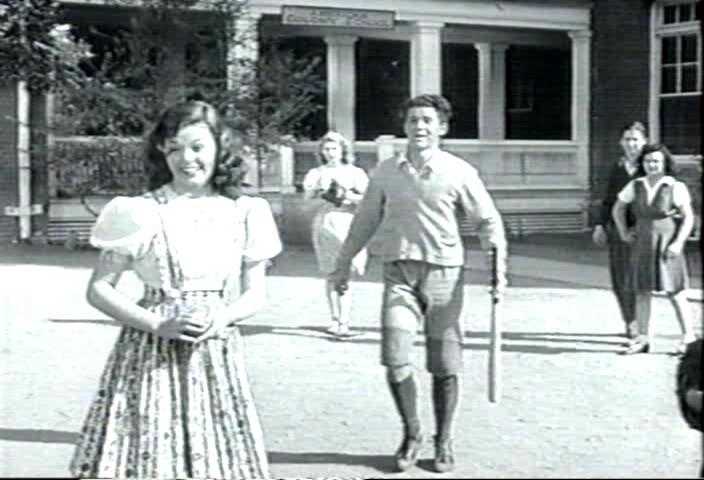Costuming
The youths at the school seem to be mostly older teenagers about 16 or 17 years old. The German boys wear Hitler Youth uniforms to school.
They wear Hitler Youth uniforms: brown shirts with Swastika
armbands, dark shorts with leather belts and straps across the chest, and white knee socks. The school is run like a military academy. This is simply a false depiction of German schools. The American and other boys at tghe private school wear mostly knickers with unpatterned
stockings. One or two boys wear long trousers, and one boy wears knee-length shorts and dark knee socks. Their clothing seems plausible. Anna after taken into custody by the NAZIs appears to be wearing a BDM uniform past the age for it.

Figure 2.--This scene shows Karl Bruner, the Hitler Youth boy (Tim Holt) in his short pants uniform. Tim Holt was a little too old to play a teenager, but later on he graduates and becomes a SS officer.
|
Accuracy
The movie is a powerful, but rather perposterous Hollywood melodrama in which some historically accurate depictions are mixed in with outright false scenes. Other aspects I am unsure about. The movie touched on the German concentration camps and euthenasia, Lebensborn, and hereditary courts with varying degress of accuarcy. The mention of some of these programs in themselves is an improvement on many Hollywood films. The Holocaust is not touched on with the exception of a Jewish boy taken away from school.
Book burning
The NAZI Book burninga appears in the opening credits. It was one of the first major NAZI acts on seizing power and seems appropriate to bring it up in the film. Such scenes were dramatic images and in the years before television were widely shown to Americans in the popular movie newsreels of the time. The book burnings were a erly event which helped to set the character of the NAZI regime in the American mind.
Hitler Youth
The impotance of ritual to the Hitler Youth is shown in the early scenes. Most of the charcters are show as either heros or villans. Less well developed is just how effecrive the Hitler Youth program was on the average boy. All of the boys in the film are shown as autonomons without individual personality. We tend to think that the Hitler Youth program was highly effective, but the film depivtion seems rather heavy handed. Unfortunately the film shifts from the Hitler Youth to an implausible love story with an sbsurd ending in which he is allowed to broadcast a anti-NAZI speech at his show trial.
Legal formalities
One inaccuracy is the suggestions by the U.S. Embassy that the NAZIs paid no attention to legalities. In factors the NAZIs were stickers for diplomatic formalities. (At least until they occupied your country.) There were excetions here. The Gestapo often ignored legal formalities when involved in state security issues or in dealing with Jews. A good example is Tvsi Nussbaum, the little Jewish boy in Warsaw. He survived because he had a foreign passport. I believe that it is very unlujely that the NAZIs would have seized a child or young adult holding an American passport, against the oparents wishes--especially before America entered the War.
Concentration camps
The NAZI concentration camps are mentioned and referred to at certain points in the film. Either by people being afraid to be sent there or by NAZIs wanting to sens people there. The references seenm appropriate. All he rederences are to the concentration campos, not the Polish death camps.
Euthenasia
The euthensaia program is mentioned. But the rederence is to an elderly couple gassed in a hospital. There was a euthenasia campaign. The focus was on handicapped children. The courts sometimes took handicapped children away from their parents and mediaccly mirdered them in sanotariums. The mentally ill and retarded children and adults were often murders, some in exoerimaental gas vans. I do not know of it being extended to the elderly, although individual doctors may have done this on their own.
Lebensborn
There is a scene at a home for expected mothers, presumably a Lebensborn home. There is a aanother absurd scene scenre where an expected mother wants the birth to hurt so she can feel that she is making a real contribution to the Führer. Unmentioned is the much larger Eindeutschung ( Germanization ) program being conducted in part through the Lebensborn program.
Hereditary courts
The NAZIs were intent on stamping out heredurary disseases, although genetics was a still very basic science. Hereitary courts were set up all over Germany to order the sterilization of children thought to be carry hereditary diseases. Many handicapped children were also sterilized. The parents had no say in the matter. They children were reported to the courts by the family doctor. The film has a graphic scene and the Cestapo officers explains that it was all quite legal. He suggests that is was not just eugenics, but individuals were sterilized for political discent. This I have not heard of.
Holocaust
The Holocaust is not touched on with the exception of a Jewish boy taken away from school. The presentaion does not suggest how the Jews were singled out. It is true that in 1943 that the German mass killings of Jews were mot yet known to the general public. There were newspaper reports, usually burried on the back pages. The public had not yet realized what was happened. Churchill knew about mass killings because of the Enigma decripts. He was reluctant to speak out forcefully least it would make the Germans nervous about signal security. I am not sure just what Roosevelt knew. He had reveived reports, but doing war all kinds of reports are received. Just what was his level of understanding or appreaciation for the extent of the killings I do not know. This while in 1943 it would be unrealistic to present a picture of the Holocaust, it was clear to any one who read the newspaper that sibstantail numbers of Jews wre being brutalized and killed in the East.
Religious persecution
Perhaps the most redidulous part of the film is the relative toleration shown by the NAZIs for the Church. The NAZIs siged a concordont with the Vatiacn, but in fact igbnored it. With the exception of a few brave pastors, the protestant clergy kept silent. The Catholic clergy did not. In response several thousand priests and nuns wwere killed. The Gestapo agent tells the priest that they do not want to create martys. In fact they made inumerable martyrs.
Reader Comments
Thanks for this excellent review. The historical inaccuracies which it details are especially notable. Overall, the film ranks as a disappointment. The relationship between the two young people somewhat overshadows the purported theme of the film. Tim Holt
and Bonita Granville, who portray the couple, seem too old for these roles. They were both about 20-21 when the film was made. Hollywood could have created far more effective wartime propoganda by crafting a film based on the real teachings and activities of the Hitler Youth.
Probably no other country has had so many films made about it by foreign film makers as Germany. Given the importance of Hollywood, popular images of Germans are in large measure influenced by these foreign depictions. This is perhaps difficult for Americans to understans as almost all important American images come from
American-made television and movie programing. Many of those film focus on the NAZI and World War II film. HBC is struck by the lack of realism in these films. Many films, especially films made before the end of the War did not begin to display the true horror of what went on in Germany or the occupied countries. Many of the depictions of Germans in these films are perhaps understandably unflatering charactures. Relatively few films have sought to show German characters as real people. HBC has wondered how Germans viewing World War II films view the scenes of American and British tanks entering German towns and villages. Most Germans would today at least intelectually say that they were liberated from the NAZI tyrany as much as the occupied countries. (The experience was different in the
areas occupied by the Red Army.) We are curious, however, if the emotional reaction is perhaps not different from the intelectual reaction.
Quite a few Hollywood films addressed World War II. The most interesting period was before America entered the War aftervthe Japanese attack on Pear Harbor. (December 1941). Before that there were no Government censorship or directiveds on content. Even so the
films made were strongly critical of the NAZIs and Japanese militarists. The most interesting fact is that during this period, there were no films made which endorsed the strong isolatiionist
sentiment that was widely held by Americans. It is also interesting to note how Hollywood ignored the Soviet aggressions. After Pearl Harbor, of course, Hollywood enthusiastically signed up for
the war effort. There were also a number of related films made after the War.
HBC

Navigate the Boys' Historical Clothing Web Site:
[Return to the Main Ha-Hl alphabetical movie page]
[Return to the Main alphabetical movie page]
[Return to the Main German movie page]
[Return to the Main Hitler Youth movie page]
[Introduction]
[Activities]
[Biographies]
[Chronology]
[Clothing styles]
[Countries]
[Topics]
[Bibliographies]
[Contributions]
[FAQs]
[Glossaries]
[Satellite sites]
[Tools]
[Boys' Clothing Home]
Created: October 16, 2001
Last updated: 9:26 PM 12/31/2004




